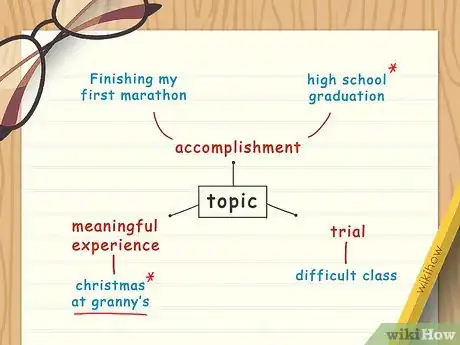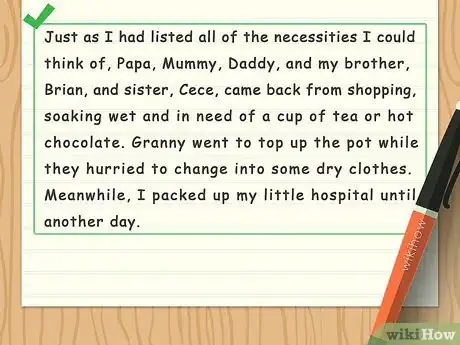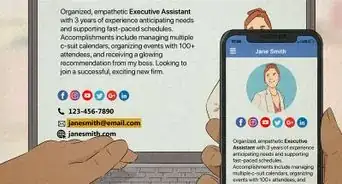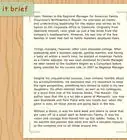This article was co-authored by Alicia Cook. Alicia Cook is a Professional Writer based in Newark, New Jersey. With over 12 years of experience, Alicia specializes in poetry and uses her platform to advocate for families affected by addiction and to fight for breaking the stigma against addiction and mental illness. She holds a BA in English and Journalism from Georgian Court University and an MBA from Saint Peter’s University. Alicia is a bestselling poet with Andrews McMeel Publishing and her work has been featured in numerous media outlets including the NY Post, CNN, USA Today, the HuffPost, the LA Times, American Songwriter Magazine, and Bustle. She was named by Teen Vogue as one of the 10 social media poets to know and her poetry mixtape, “Stuff I’ve Been Feeling Lately” was a finalist in the 2016 Goodreads Choice Awards.
There are 11 references cited in this article, which can be found at the bottom of the page.
wikiHow marks an article as reader-approved once it receives enough positive feedback. This article received 32 testimonials and 100% of readers who voted found it helpful, earning it our reader-approved status.
This article has been viewed 855,580 times.
An autobiographical essay is just an essay about something you experienced. Even so, writing an autobiographical essay can be challenging. You might write an autobiographical essay for a class, an application, or just for your own personal enjoyment. Whatever your reason, there are some key concepts and strategies that you will want to keep in mind as you write. Keep reading to learn more about how to write an autobiographical essay.
Steps
Planning Your Essay
-
1Choose a story that you really want to tell or that you just want to get out of your system. One of the best ways to write a good story is to choose a story that you really care about telling. Remember, you will need to write about a specific aspect of your life, not your entire life. The story of your entire life could fill the pages of a book. Instead, choose a topic that you can discuss in a detailed way over the course of your essay.[1] Some options you might consider include:
- an accomplishment like winning an award, getting a job, or graduating from high school
- a trial like a difficult class, an injury, or losing a loved one
- a meaningful experience like discovering a hobby, meeting your best friend, going away to camp, or learning something about yourself
- Make sure that you are comfortable sharing your story. Don’t write about anything too hard or heartbreaking if you are not emotionally ready to handle it.
-
2Define your purpose for writing. Think about what you want to accomplish with your autobiographical essay. Why do you want to tell this story? What do you hope to accomplish by telling this story?[2]
- If you are writing an autobiographical essay for an application, make sure that you read the instructions well. If the application includes a prompt or question that you need to answer, make sure that the story you intend to tell will respond to this prompt or question.
- If you are writing an autobiographical essay for a class, make sure that you read the assignment guidelines well. Make sure that the story you intend to tell will work for this assignment. Ask your instructor if you have any questions about the assignment.
Advertisement -
3Consider your audience. Think about who will be reading your autobiographical essay. Consider the needs and expectations of your readers before you begin writing. Jot down some of the things that you will need to keep in mind about your readers as you write your autobiographical essay.[3]
- If you are writing your essay as part of an application, consider what your readers will be most interested in hearing about.
- If you are writing your essay for a class assignment, consider what your instructor will expect you to include in your essay.
-
4Generate ideas for your autobiography. Before you begin writing your essay, you should take some time to flesh out your ideas and get some things down on paper. Invention activities like listing, freewriting, clustering, and questioning can help you to develop ideas.[4]
- Try listing. List the ideas that you have for your autobiography and then look over the list you have made and group similar ideas together. Expand those lists by adding more ideas or by using another prewriting activity.[5]
- Try freewriting. Write nonstop for about 10 minutes. Write whatever comes to mind and don’t edit yourself. Review what you have written. Highlight or underline the most useful information for your autobiography. Repeat the freewriting exercise using the passages you underlined as a starting point. You can repeat this exercise many times to continue to refine and develop your ideas.[6]
- Try clustering. Write a brief explanation of the subject of your autobiography on the center of a piece of paper and circle it. Then draw three or more lines extending from the circle. Write a corresponding idea at the end of each of these lines. Continue developing your cluster until you have explored as many connections as you can.[7]
- Try questioning. On a piece of paper, write out “Who? What? When? Where? Why? How?” Space the questions about two or three lines apart on the paper so that you can write your answers on these lines. Respond to each question in as much detail as you can.[8]
-
5Make an outline. Once you have gotten some of your ideas on paper, organize those ideas into an outline before you begin drafting your essay. You can Write an Essay Outline to plan out your whole essay, develop more ideas, and figure out if you have forgotten anything.
- It may be helpful to decide where to start from and where to finish, and then work on filling in the middle.
Drafting Your Essay
-
1Write in the first person. Use the first person perspective (I, me, my, mine) when writing your autobiographical essay. You share your own experiences in an autobiographical essay, so use the first person perspective. [9]
- Do not use the second person perspective (“you”) or switch back and forth between “I” and “you.” Use the first person perspective (“I”) throughout your entire essay.
-
2Begin with an engaging sentence that gets right into your story. Your introduction should immediately begin telling your story. Think about what you will discuss in your essay to help you determine what you should include in your introduction. Your introduction should also identify the main idea of your autobiographical essay and act as a preview to your story.[10]
- Jump right in. One way to begin a story is to immediately begin describing something that happened, even if it happened in the middle of your story. You might start with something like, “There I was, standing in front of the entire 10th grade reading a story I had written.”[11]
- You can start writing your draft in any order that you like, but then remember to organize the completed story in the proper order.
-
3Describe the setting. Use vivid details to describe the setting of your autobiography to your readers. Provide context and background that they will need to understand the rest of your essay.[12]
- Say something tantalizing to your reader. For example, you might start with something like, "I never expected to be as happy as I was on that day." Or, "Many things have happened to me in my life, but this was the worst.” Just make sure that the opening fits with your topic.
- Avoid beginnings that are too general or broad. Never open with, “Since the dawn of time…” This type of opening does not help your reader understand what your story is about. "Too general" openings are boring as well.[13]
- Avoid opening with a quote, unless it is meaningful to you and crucial to your story. If you want to include a meaningful quote in your autobiographical essay, it should have something to do with your story. You should talk about what it means to you when you provide it.
-
4Transition from the introduction into your story. After you have introduced your story and hooked your readers, you will need to transition into telling the story. End your introduction with a sentence that will leave your readers excited to continue reading.[14]
- You might say something like, “Under these circumstances, I began the most challenging year of my life.” Or, “Before this happened, I had no idea that I could do something so huge.” Choose a transition that fits your introduction and that will connect with the ideas in your next paragraph.
-
5Tell your story. After you have introduced your story, you will need to tell your readers what happened, step-by-step. Your second paragraph and the ones that follow will depend on where you left off in your introduction. Make sure that you do not skip over important details that your readers might need or want to know about.
-
6Conclude your story. Your conclusion should be memorable and interesting. You should end your story in a way that wraps up your loose ends and provides some reflection on the experience.[15]
- Talk about why this story is significant to you and what you learned from it.[16]
- Refer to the beginning of your story in the end by mentioning a situation or person that was central to your introduction.[17]
- Tell your readers about something that came out of this experience that you were not expecting.[18]
Enhancing Your Essay
-
1Include lots of vivid details and dialogue where appropriate. Vivid details and dialogue help bring your story alive for your readers. Describe the people, surroundings, and other relevant aspects of your autobiography.[19] [20]
- Instead of saying that your teacher wore a blue dress, say that it was aqua blue with white lace trim on the sleeves.
- Instead of saying you felt nervous, describe your trembling hands, the knot in your stomach, and the weak feeling in your knees.
- Instead of saying that you spoke to your teacher about something important, put the conversation that you had with your teacher into dialogue.
-
2Consider organizing your story in a non-chronological manner. Telling your story in the order it happened is effective, but there are other ways of organizing an autobiography. Consider different organizational patterns before you pick one.[21]
- Use chronological organization if you want to start at the beginning and describe your story in the order that it happened.
- Use starting in the middle organization if you want to put your readers into the midst of your story and then go back to the beginning.
- Use starting at the end organization if you want to tell your readers how your story ended up and then explain how you got to that point.
-
3Be yourself. One of the worst things you can do when writing an autobiographical essay is to represent yourself in a way that does not reflect who you are. Make sure that your essay reflects your experiences and personality.[22]
- Don’t be afraid to show your sense of humor, as long as you don’t think it will disrupt the tone of your essay. In other words, if you are telling a sad story, using sarcasm or making a joke about something serious might not be appropriate.
Writing Help
Community Q&A
-
QuestionShould I write about every single part of my life?
 Community AnswerNot necessarily. Instead, focus on the most important parts of your life, especially the ones that contributed to who you are today.
Community AnswerNot necessarily. Instead, focus on the most important parts of your life, especially the ones that contributed to who you are today. -
QuestionCan I talk about my career and goals?
 Community AnswerYes, but these tend to be common autobiographies and are not very creative. Try to add your own personal twist to make it unique and creative in order to get more readers.
Community AnswerYes, but these tend to be common autobiographies and are not very creative. Try to add your own personal twist to make it unique and creative in order to get more readers. -
QuestionHow can I write the best essay?
 Community AnswerMake a list of the important areas in your life. Write a draft. Use details to improve your essay.
Community AnswerMake a list of the important areas in your life. Write a draft. Use details to improve your essay.
References
- ↑ http://study.com/academy/lesson/what-is-an-autobiographical-essay-biography-examples.html
- ↑ http://www.wwnorton.com/college/english/write/fieldguide/writing_guides.asp#BLUE08
- ↑ http://www.wwnorton.com/college/english/write/fieldguide/writing_guides.asp#BLUE08
- ↑ http://writing.ku.edu/prewriting-strategies
- ↑ http://writing.ku.edu/prewriting-strategies
- ↑ http://writing.ku.edu/prewriting-strategies
- ↑ http://writing.ku.edu/prewriting-strategies
- ↑ http://writing.ku.edu/prewriting-strategies
- ↑ https://selfpublishingadvice.org/writing-when-to-use-first-person/
- ↑ https://www.esu.edu/writing-studio/guides/hook.cfm
- ↑ http://www.wwnorton.com/college/english/write/fieldguide/writing_guides.asp
- ↑ http://www.wwnorton.com/college/english/write/fieldguide/writing_guides.asp
- ↑ https://www.otago.ac.nz/classics/otago055219.pdf
- ↑ http://www.writing.ucsb.edu/faculty/donelan/para.html
- ↑ http://www.wwnorton.com/college/english/write/fieldguide/writing_guides.asp#BLUE08
- ↑ http://www.wwnorton.com/college/english/write/fieldguide/writing_guides.asp#BLUE08
- ↑ http://www.wwnorton.com/college/english/write/fieldguide/writing_guides.asp#BLUE08
- ↑ http://www.wwnorton.com/college/english/write/fieldguide/writing_guides.asp#BLUE08
- ↑ http://writetodone.com/how-to-use-vivid-description-to-capture-attention/
- ↑ http://www.wwnorton.com/college/english/write/fieldguide/writing_guides.asp
- ↑ http://www.wwnorton.com/college/english/write/fieldguide/writing_guides.asp#BLUE07
- ↑ http://www.cbsnews.com/news/10-great-opening-lines-from-stanford-admissions-essays/
About This Article
To write an autobiographical essay, choose a story from your own life that you're excited to share. Consider who your audience is when selecting a story and go with something that will appeal to them. Next, create an outline for your essay to help you organize all of your thoughts. When you're ready to get started, kick off your essay with an engaging sentence, then jump right into the action to hook your readers. Remember to write in first person and include vivid details to bring your story to life. Let your unique personality shine through! To learn how to enhance your essay by including dialogue, keep reading the article!












































































